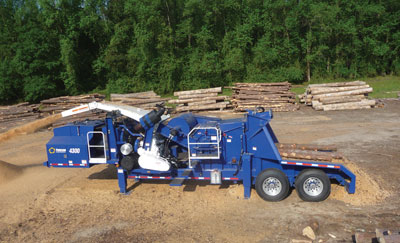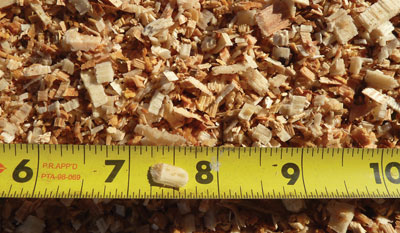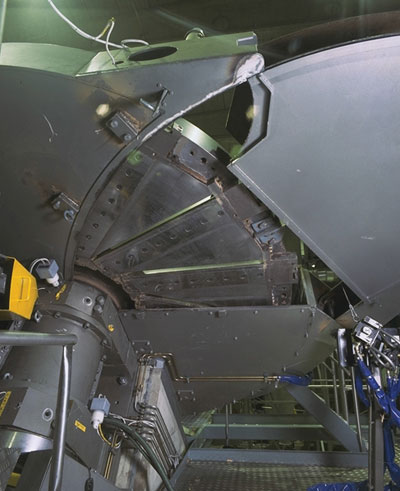
Small Is Beautiful: Microchipping Woody Biomass
December 2, 2011
By Treena Hein
Although the use of microchipping in wood pellet manufacture is just catching on in North America, European pellet makers discovered “small is beautiful” some time ago.
Although the use of microchipping in wood pellet manufacture is just catching on in North America, European pellet makers discovered “small is beautiful” some time ago. “The advantages of green microchips stem from the fact that average chip moisture and drying characteristics are measurable and easily adjusted,” observes Clyde Stearns, vice-president of engineering at Zilkha Biomass Energy, a producer of renewable fuel such as pellets based in Houston, Texas. “Moisture within chips is more constant, as is the moisture variance between chips.”
 |
|
| The Peterson 4300 microchipper has 12 pockets to make four cuts per revolution compared to six pockets and two cuts per revolution on a standard chipping drum.
|
These qualities mean that microchips dry more evenly in a rotary or belt dryer. “Dried chip moisture content might vary from 3 to 20% MCWB with large chips (1 inch x 1 inch x 3/8 inch) as a result of over-drying of the small particles and under-drying of the large chips,” notes Stearns. “Moisture content using microchips in the same dryer might vary from about 7 to 12% MCWB.” Microchips also provide better dry grinding. “You need less grinding energy,” Stearns observes. “The microchips also provide a better particle size distribution for pelleting, resulting in both improved quality (more dense pellets) and quantity.”
The only negative is that chipping green wood to a microchip chip size requires a large chipping machine and therefore more energy overall, notes Stearns. However, if you look at pellet production and compare it with the use of conventional chips, microchipping provides big overall cost savings. “The microchipper allows you to go from a log to a microchip and then to a final grind, whereas with conventional size chips, a secondary grind is required before the final grind,” says Michele Morrill, communications director at Continental Biomass Industries Inc. (CBI) of New Hampshire. “Eliminating the secondary grind for a pellet plant will save a huge amount of energy, cost and capital equipment.”
 |
|
| Microchips can be cut to a variety of lengths, ranging from 30 mm to 6 mm, depending on the rotor pockets of the chipper.
|
Several companies such as CBI have developed systems to allow microchips to be made right from their machines without further processing. CBI’s Magnum Force 8400 chipper can produce uniform chips ranging in size from 30 mm to 6 mm simply by changing the optional rotors and anvil spacing. (Its smaller ChipMax 484 also has the capacity of producing 30 mm to 6 mm chips.) About eight Magnum Force 8400 units are being used in Europe in microchipping as part of pellet production. “Its large feed opening and long feed conveyor make it easy to feed short to long and large-diameter wood,” notes Morrill. “Our two-pocket rotor produces chips from 30 mm to 15 mm, and our four-pocket rotor produces chips from 15 mm to 6 mm.” She says there is a moderate cost difference to set up an 8400 to produce microchips – the four-pocket rotor costs more than the two-pocket rotor.
Cardinal Saw in Angliers, Quebec (a Canadian distributor for Morbark) has adapted a standard Morbark 30-36 chipper to produce microchips, and has sold one of these modified units so far, to a Canadian pellet producer. Owner Gaétan Bernèche says the modifications are simple and inexpensive. “All it needs is adapted knife holders and knife setting,” he explains. “The extra cost would only be in reduced chip production volume, which is minimal.”
Peterson Pacific Corporation offers several machines that can produce microchips. “Our 4300 and 4310 drum chippers utilize special components for microchip applications,” says marketing manager Michael Spreadbury. “Microchips can also be made with our disc chippers after converting components.” He notes that normal chippers used for pulp chips or fuel chips should have a chipping speed in the range of 1500 to 1800 M/min. “This is the best speed to minimize overly thick chips and pins,” says Spreadbury. “Peterson therefore increased the microchip drum and disc speed to increase production.” The Peterson microchip drum has 12 pockets to make four cuts per revolution versus six pockets and two cuts per revolution on a standard chipping drum. Optional screens are recommended for the application to break up any longer-sized pieces. Peterson disc chippers can be equipped with a six-pocket chipper disc to increase production in a microchip application.
Peterson also has a special drum chipper belly band designed to break up the chips so the average chip width is narrower.
“Many microchip applications need maximum surface area for drying or chemical reactions,” Spreadbury says. “We have many customers that are testing microchips for pellets, co-firing with coal, gasification, enzymatic hydrolysis and animal bedding applications.” He observes that the cost of producing 4 to 6 mm microchips will be two to three times that of producing a typical 25 mm chip because of the extra energy and knife cost to reduce the fibre into shorter lengths. “The knives also need to be maintained with a sharper edge with microchips,” he says. “Peterson offers the option of standard babbitted knives or replaceable knife inserts than can be changed more quickly.”
Like others, Spreadbury thinks that even though the cost of producing microchips is much higher than with standard chips, the overall pellet production process savings can still be dramatic over alternative multiple reduction steps that begin with longer fibre particles. “Hammermills are very inefficient in reducing wood to shorter fibres compared to chipping the fibre to length with a sharp chipping blade,” he says.
Pellet makers using microchipping
Ozark Hardwood Products in Seymour, Missouri, is very pleased with microchipping as part of its pellet production process. The company sells chips, mulch and pellets (for residential and commercial building heat) made from local oak and hickory. “For pellet making, we’d relied on sawmill residuals, but in 2007 and 2008 with the economic downturn, the sawmills in this region started to shut down or reduce their operation, and we had to make a change,” says general manager Mike Ferguson.
 |
|
| Andritz's HHQ-Horizontal Chipper is being used by pellet mills to make microchips. Although microchipping involves more energy at the outset of its production compared to normal chipping, it requires less energy to be completed.
|
Microchipping seemed the answer. Ferguson did a lot of investigation before making a decision, travelling around the US and to Canada and Europe, before finally settling on CBI’s Magnum Force 6400 microchipper, which they started using in May 2009. “Even though other models have come out from other companies and from CBI since our purchase, I feel it’s still the best chipper for us,” Ferguson says. “We chose it because of the product it produces, the rate per hour, the size, and quality of the build.” He says they use the 6400 every day, and that CBI has provided good support when there have been any occasional questions.
Microchipping is also being used as part of pellet manufacture at RWE’s “Georgia Biomass” plant in Waycross, Georgia, that started up in May 2011. By the end of June, the plant’s first shipload of pellets departed from the port of Savannah on its way to the RWE and Essent Amercentrale in the Netherlands, a power plant that previously used only coal. Georgia Biomass is producing about 750,000 tons of wood pellets per year (all for use in Europe) which requires about 1.5 million tons of green wood annually. The contract for the woodyard processing equipment (debarking/chipping/screening) was awarded to Andritz, and microchipping is being used due to expected better all-over energy efficiency in the complete production process.
Andritz Wood Processing recently completed a study in Finland on how to provide customers with the ability to produce microchips best suited for the pelleting process. “With the North American industry trend towards tree length debarking/chipping for wood pelleting, we wanted to provide a chipper that can produce microchips efficiently and cost-effectively,” says Joanne Turnell, Andritz’s Canadian sales and marketing co-ordinator (wood processing-drying technologies-feed and biofuel). “We found that our HHQ-Horizontal Chipper not only offers high chip quality due to advanced chipping geometry, it also offers flexibility for changing process needs and chip size requirements.” She notes that the largest pellet-producing facilities in the world are using the HHQ Chipper. “With the biofuel industry growing continually worldwide, producing microchips makes good economic sense,” says Turnell, “in both large and smaller pellet-making operations.”
Print this page